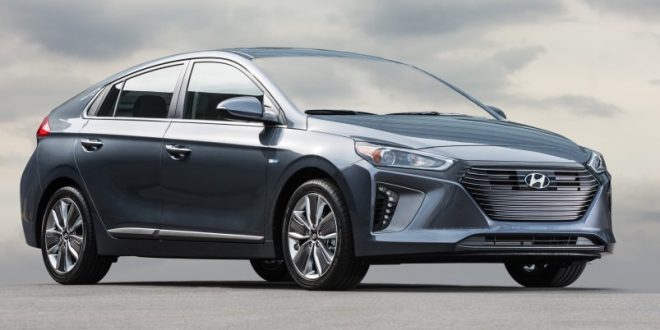The 2017 Hyundai Ioniq isn’t one car but three, with a unique choice of powertrains.
The 2017 Hyundai Ioniq is an alternative propulsion vehicle with a hatchback body style. Available in three different variants, hybrid, plug-in hybrid, and all-electric, the Ioniq is aimed at the likes of the Toyota Prius, Chevrolet Bolt and Volt, and the Audi A3 e-tron. The Ioniq is a sister vehicle to the 2017 Kia Niro, which it shares a platform with and will be available in hybrid or plug-in hybrid versions but not as an EV.
Overview
Three variants of the 2017 Hyundai Ioniq will be released with the first being a conventional hybrid powered by a new 1.6-liter I-4 coupled to a 32-kW electric motor and a 1.56-kWh lithium-ion battery. Total system output is 139 hp. There’s also a plug-in variant that takes the same engine and pairs it to a more powerful 45-kW electric motor backed by an 8.9-kWh lithium-ion battery. Hyundai estimates that the Ioniq PHEV will be able to travel over 25 miles on EV mode. Both the Ioniq Hybrid and Ioniq PHEV feature a six-speed dual-clutch automatic transmission instead of a continuously variable transmission, which is what most hybrids and PHEVs use.
The Ioniq Electric uses an electric motor with 120 hp and 215 lb-ft of torque and puts its power down through a single-speed automatic. On a single charge, Hyundai estimates the Ioniq Electric will be able to travel 110 miles. Using a 240V (level 2) charger, it takes four hours and 24 minutes to fully charge the Ioniq Electric. The car is also compatible with DC fast chargers and can get the car back to 80 percent in 24 miles and 90 percent charge in 33 minutes.
As with every Hyundai product, the Ioniq offers a long list of standard and optional features including a rearview camera, heated front seats a 4.2-inch display in between the gauges, a seven- or eight-inch touchscreen, navigation, leather upholstery, HID headlights, LED headlights on the PHEV and Electric variants, rear parking sensors, a sunroof, wireless charging, an Infinity premium audio system, as well as Android Auto and Apple CarPlay compatibility.
Because it’s a hatchback, the Ioniq also offers generous cargo space at 26.5 cubic feet for the standard hybrid and 23.0 cubic feet of the EV and PHEV. All variants come standard with 60/40 split-folding rear seat in case you need more space for hauling your gear.
Safety
A host of active safety features will be available for the 2017 Hyundai Ioniq lineup including automatic emergency braking, forward collision warning, lane departure warning, lane keeping assist, bind spot warning, adaptive cruise control and rear cross-traffic alert.
Agencies/Canadajournal
 Canada Journal – News of the World Articles and videos to bring you the biggest Canadian news stories from across the country every day
Canada Journal – News of the World Articles and videos to bring you the biggest Canadian news stories from across the country every day




As for your question, I was all set to buy a Chevy Bolt, but since it isn’t yet available in PA, I ended up taking over a friends e-Golf lease while I await the next generation of 200+ mph range vehicles. I love the Bolt’s form factor – short length making it easier to park and store yet huge interior so you’re not compromising space. I like it’s CUV styling as well with a higher seating position, making it easier to get in and out of.
The Ionic looks like it has a nicer interior and it appears more ‘conventional’, but I’m personally not interested in another sedan/low-hatchback – they just waste too much potential interior space and the low seating position provides worse visibility and makes it harder to enter/exit – something often ignored but necessary as we and our passengers age.
The final deal breaker for me however is the range – the Bolt changed my expectations. At this point, I wouldn’t buy any EV without a 200+ mile range. You know that every manufacturer is going to set this as a benchmark, so I see the Ionic and it’s contemporaries with 100ish mile range as DOA.